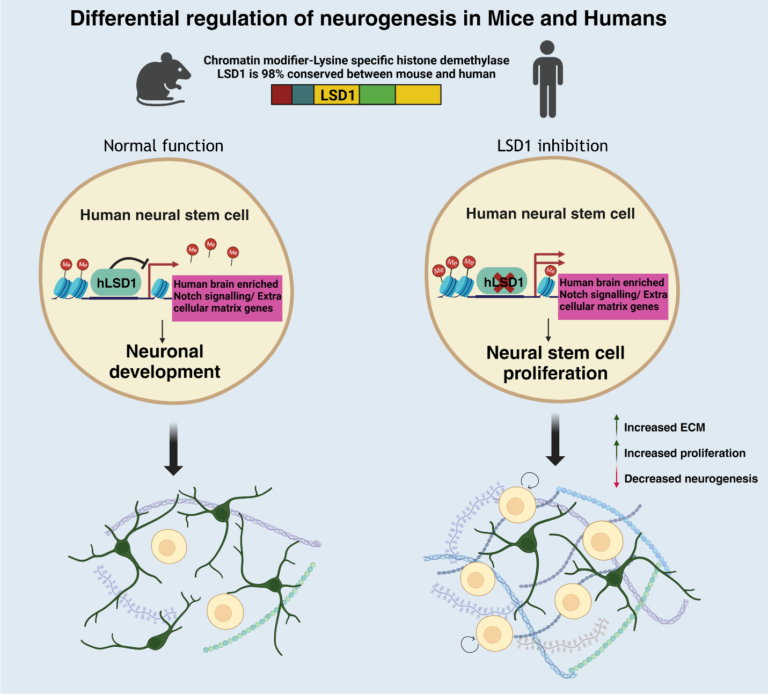Deciphering human neuron generation- LSD1’s Pivotal role
Work done in the lab of Dr. Bhavana Muralidharan at the Institute for Stem Cell Science and Regenerative Medicine (inStem)
Asha S Channakkar has completed my Master’s in Biochemistry from the University of Hyderabad. Post which she worked as a project assistant at the National Brain Research Centre, Manesar, where she worked on understanding the role of microRNA in human neuronal development (Channakkar et al., STEM CELLS.2020). Currently, I am a graduate student at the Muralidharan lab, inStem. She joined the lab in 2020. Here, her research work focuses on understanding chromatin modifiers in neuronal development using human and mouse model systems.
Author Interview
How would you explain your research outcomes to the non-scientific community?
Neurons are like the brain’s messengers – they fire up and connect to form circuits, much like the wiring in electrical circuits. Imagine billions of these circuits made by millions of neurons, working together when we think, talk, walk, or dance. Different activities have different circuits in the brain.
There is a group of special cells called neural stem cells, acting like the brain’s builders. They split into two, creating new cells known as neurons. We humans have more neurons and a more complex brain than mice, with a larger overall size.
The process of neural stem cells dividing and making neurons is controlled by switching genes on or off. These genes give instructions for building and organizing the brain. Proteins called chromatin modifiers act as modulators in turning these gene switches on and off. We study one such chromatin modifier called LSD1. LSD1 does this by influencing histone proteins that wrap around DNA, keeping it compact and in different states.
In our study, we explored how LSD1 manages stem cell function and the creation of neurons by controlling the expression of various genes. We found that LSD1 is crucial in balancing the division of neural stem cells and the generation of neurons.

“The findings from our study significantly contribute to the understanding of human neurogenesis within the complex landscape of the brain.”
How do these findings contribute to your research area?
The findings from our study significantly contribute to the understanding of human neurogenesis within the complex landscape of the brain. The human brain, composed of diverse cell types, undergoes a precise temporal and spatial development, resulting in specialized regions responsible for various functions such as cognition, emotions, motor skills, and thought processing.
Throughout evolution, the human brain has undergone rapid changes, particularly in the neocortex, which governs higher-order functions like executive function and cognition. The molecular mechanisms underlying these changes remain largely unknown and are actively under investigation. Recent studies have emphasized the role of the extracellular niche surrounding proliferating neural cells in driving accelerated proliferation and increased neuronal output.
Our study’s key contribution lies in shedding light on the specific mechanisms of human neuronal development. Despite LSD1 being a highly conserved gene across species, our research highlights its ability to induce distinct functions in humans by regulating downstream effector molecules that are enriched or specific to the human brain. This raises important questions about the regulation of LSD1 function between mice and humans, the potential cofactors influencing this unique function in human neural stem cells, and whether LSD1 played a significant role in the evolutionary expansion of the human cortex through its interaction with various downstream effectors.
These findings not only deepen our understanding of human-specific neuronal development but also open avenues for further research, encouraging exploration into the intricacies of regulatory mechanisms of LSD1 and its potential role in the evolutionary expansion of the human brain.
What was the exciting moment during your research?
The entire journey through this fascinating study was both thrilling and challenging. From conducting experiments to analyzing data and preparing the manuscript, every step was filled with excitement and learning. The experience was particularly rewarding as it presented a steep learning curve, teaching me how to formulate the right questions and address them through well-planned and executed experiments.
Throughout this process, the constant support of my principal investigator, Dr. Bhavana Muralidharan, was exceptional. Her guidance was especially valuable during moments of discouragement resulting from failed experiments or setbacks in the experimental paradigms.
Presenting the data at various conferences and meetings was a source of joy, accompanied by valuable feedback and suggestions. The pinnacle of excitement came with the publication of our work in a renowned journal, providing both a sense of accomplishment and motivation for upcoming projects in the lab.
What do you hope to do next?
I have a deep passion for Neuroscience research, and my current work as a graduate student has only fueled that interest. Looking ahead, upon completing my PhD studies, I aspire to pursue postdoctoral research in the field of developmental neuroscience, emphasizing on mechanisms underlying neurodevelopmental disorders, with the goal of paving the way for therapeutic advancements.
Where do you seek scientific inspiration from?
My scientific inspiration stems from a profound curiosity about the intricacies of the brain and the mechanisms governing its development and functionality. Several factors fuel my motivation in scientific pursuits, including engaging with the scientific community to stay abreast of current developments. As an avid reader, I constantly seek to stay updated on the latest research in my field of interest. Moreover, the stimulating research questions we are currently exploring in the lab contribute to an unquenchable thirst for answers, driving my enthusiasm to work towards unraveling these mysteries.
How do you intend to help Indian science improve?
One can compare Indian science to an actively growing tree. Given an opportunity, I would like to support its growth by improving the training of younger minds. I would like to emphasize on nurturing the ability to ask pertinent questions and designing effective experiments. Strengthening our scientific community involves fostering collaborations between labs and clinicians, amplifying our collective impact. Additionally, we can together encourage international collaborations, with a particular focus on studying diseases prevalent in the Indian demographic. Through these initiatives, I hope to play a role in elevating the quality and reach of Indian science.
Reference: Asha S Channakkar, Leora D’Souza, Aparajita Kumar, Kishan Kalia, Srilekha Prabhu, Kruttika Phalnikar, Puli Chandramouli Reddy, Bhavana Muralidharan, LSD1 Regulates Neurogenesis in Human Neural Stem Cells Through the Repression of Human-Enriched Extracellular Matrix and Cell Adhesion Genes, Stem Cells, 2023; sxad088, https://doi.org/10.1093/stmcls/sxad088
Biopatrika: Bringing Science to Society
© Biopatrika 2024 All Rights Reserved.
